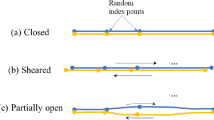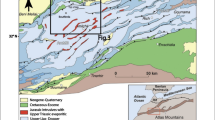Abstract
— There are currently three major competing views on the essential geometrical, mechanical, and mathematical nature of faults. The standard view is that faults are (possibly segmented and heterogeneous) Euclidean zones in a continuum solid. The continuum-Euclidean view is supported by seismic, gravity, and electromagnetic imaging studies; by successful modeling of observed seismic radiation, geodetic data, and changes in seismicity patterns; by detailed field studies of earthquake rupture zones and exhumed faults; and by recent high resolution hypocenter distributions along several faults. The second view focuses on granular aspects of fault structures and deformation fields. The granular view is supported by observations of rock particles in fault zone gouge; by studies of block rotations and the mosaic structure of the lithosphere (which includes the overall geometry of plate tectonics); by concentration of deformation signals along block boundaries; by correlation of seismicity patterns on scales several times larger than those compatible with a continuum framework; and by strongly heterogeneous wave propagation effects on the earth's surface. The third view is that faults are fractal objects with rough surfaces and branching geometry. The fractal view is supported by some statistical analysis of regional hypocenter locations; by long-range correlation of various measurements in geophysical boreholes; by the fact that observed power-law statistics of earthquakes are compatible with an underlying scale-invariant geometrical structure; by geometrical analysis of fault traces at the earth's surface; and by measurements of joint and fault surfaces topography.¶There are several overlaps between expected phenomenology in continuum-Euclidean, granular, and fractal frameworks of crustal deformation. As examples, highly heterogeneous seismic wavefields can be generated by granular media, by fractal structures, and by ground motion amplification around and scattering from an ensemble of Euclidean fault zones. A hierarchical granular structure may have fractal geometry. Power-law statistics of earthquakes can be generated by slip on one or more heterogeneous planar faults, by a fractal collection of faults, and by deformation of granular material. Each of the three frameworks can produce complex spatio-temporal patterns of earthquakes and faults. At present the existing data cannot distinguish unequivocally between the three different views on the nature of fault zones or determine their scale of relevance. However, in each observational category, the highest resolution results associated with mature large-displacement faults are compatible with the standard continuum-Euclidean framework. This can be explained by a positive feedback mechanism associated with strain weakening rheology and localization, which attracts the long-term evolution of faults toward progressive regularization and Euclidean geometry. A negative feedback mechanism associated with strain hardening during initial deformation phases and around persisting geometrical irregularities and conjugate sets of faults generates new fractures and granularity at different scales. We conclude that long-term deformation in the crust, including many aspects of the observed spatio-temporal complexity of earthquakes and faults, may be explained to first order within the continuum-Euclidean framework.
Similar content being viewed by others
Author information
Authors and Affiliations
Additional information
(Received, November 2, 2000, accepted April 6, 2001)
Rights and permissions
About this article
Cite this article
Ben-Zion, Y., Sammis, C. Characterization of Fault Zones. Pure appl. geophys. 160, 677–715 (2003). https://doi.org/10.1007/PL00012554
Issue Date:
DOI: https://doi.org/10.1007/PL00012554




